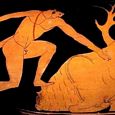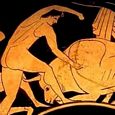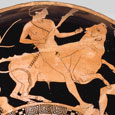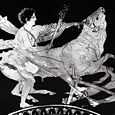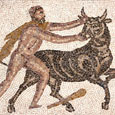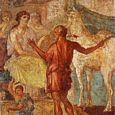TAUROS KRETAIOS
Greek Name
Ταυρος Κρηταιος
Transliteration
Tauros Kretaios
Latin Spelling
Taurus Cretaeum
Translation
Bull of Crete
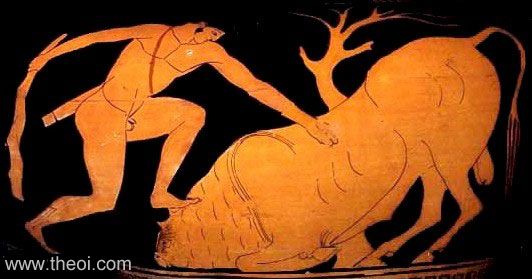
THE TAUROS KRETAIOS (Cretan Bull) was a handsome bull sent forth from the sea by Poseidon. Queen Pasiphae of Krete lusted after the animal and coupled with it by hiding inside a wooden cow crafted by the artificer Daidalos (Daedalus). She later gave birth to the Minotauros (Minotaur), a man with the head of a bull.
Herakles was commanded to fetch the Kretan Bull as one of his Twelve Labours. Upon completion of this task he set the creature free and it eventually found its way to the Athenian town of Marathon where it laid waste to the countryside. There it was finally destroyed by the hero Theseus.
The gods placed the bull among the stars as the Constellation Taurus, along with the Hydra, Nemean Lion and other creatures from the labours of Herakles.
FAMILY OF THE CRETAN BULL
OFFSPRING
MINOTAUROS (by Pasiphae) (Apollodorus 3.8, Callimachus Hymn 4.311, Diodorus Siculus 4.77.1, Philostratus Elder 1.16, Hyginus Fab. 40, Ovid Met. 8.130, Virgil Aeneid 6.24; Seneca Phaedra 112, Suidas)
ENCYCLOPEDIA
CRETAN BULL. According to Acusilaus, this bull was the same as the one which had carried Europa across the sea; according to others, he had been sent out of the sea by Poseidon, that Minos might sacrifice him to the god of the sea. But Minos was so charmed with the beauty of the animal, that he kept it, and sacrificed another in its stead. Poseidon punished Minos, by making the fine bull mad, and causing it to make great havoc in the island. Heracles was ordered by Eurystheus to catch the bull, and Minos, of course, willingly allowed him to do so. Heracles accomplished the task, and brought the bull home on his shoulders, but he then set the animal free again. The bull now roamed about through Greece, and at last came to Marathon, where we meet it again in the stories of Theseus. (Apollod. ii. 5. § 7; Paus. i. 27. § 9, v. 10. § 2; Hygin. Fab. 30; Diod. iv. 13, &c.; Serv. ad Aen. viii. 294.)
Source: Dictionary of Greek and Roman Biography and Mythology.
ALTERNATE NAMES
Greek Name
Ταυρος Μαραθονιος
Transliteration
Tauros Marathonios
Latin Spelling
Taurus Marathonium
Translation
Bull of Marathon
CLASSICAL LITERATURE QUOTES
MINOS, PASIPHAE & THE CRETAN BULL
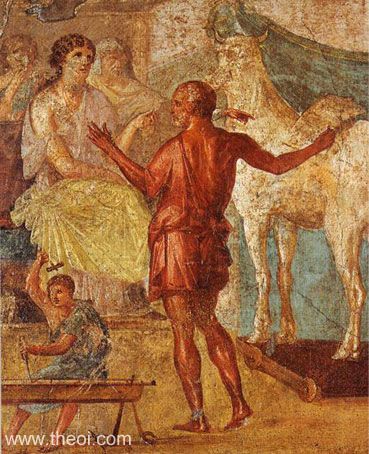
Bacchylides, Fragment 26 (trans. Campbell, Vol. Greek Lyric IV) (Greek lyric C5th
B.C.) :
"Pasiphae . . . Kypris (Cypris) [Aphrodite] implanted desire in her . . ((lacuna)) to Eupalamos' son
Daidalos (Daedalus), most skilled of carpenters, she told her unspeakable sickness [i.e. lust for a bull]; she
made him swear a binding oath and ordered him to build a wooden cow, so that she might join her body to that of
the mighty bull, hiding from Minos . . ((lacuna)) the union she shared."
Pseudo-Apollodorus, Bibliotheca 3. 8 - 11 (trans. Aldrich) (Greek mythographer C2nd
A.D.) :
"Asterios (Asterius) [King of Krete (Crete)] died childless. Minos aspired to the throne, but was rebuffed.
He claimed, however, that he had received the sovereignty from the gods, and to prove it he said that whatever
he prayed for would come about. So while sacrificing to Poseidon, he prayed for a bull to appear from the depths
of the sea, and promised to sacrifice it upon its appearance. And Poseidon did send up to him a splendid bull.
Thus Minos received the rule, but he sent the bull to his herds and sacrificed another. Poseidon was angry that
the bull was not sacrificed, and turned it wild. He also devised that Pasiphae should develop a lust for it. In
her passion for the bull she took on as her accomplice an architect named Daidalos (Daedalus) . . .
He built a woden cow on wheels, took it, hollowed it out in the inside, skinned a real cow, and sewed the
contraption into the skin, and then, after placing Pasiphae inside, set it in a meadow where the bull normally
grazed. The bull came up and had intercourse with it, as if with a real cow.
Pasiphae gave birth to Asterios, who was called Minotauros (Minotaur). He had the face of a bull, but was
otherwise human. Minos, following certain oracular instructions, kept him confined and under guard in the
labyrinth. This labyrinth, which Daidalos built, was a cage with convoluted flextions that disorders
debouchment.”
Diodorus Siculus, Library of History 4. 13. 4 (trans. Oldfather) (Greek historian
C1st B.C.) :
"The next Labour which Herakles undertook was to bring back from Krete the bull of which, they say,
Pasiphae had been enamoured."
Diodorus Siculus, Library of History 4. 77. 1 :
"Now according to the myth which was handed down to us Pasiphae, the wife of Minos, became enamoured of the
bull, and Daidalos (Daedalus), by fashioning a contrivance in the shape of a cow, assisted Pasiphae to gratify
her passion.
In explanation of this the myths offer the following account: before this time it had been the custom of Minos
annually to dedicate to Poseidon the fairest bull born in his herds and to sacrifice it to the god; but at the
time in question there was born a bull of extraordinary beauty and he sacrificed another from among those which
were inferior, whereupon Poseidon becoming angry at Minos, caused his wife Pasiphae to become enamoured of the
bull. And by means of the ingenuity of Daidalos Pasiphae had intercourse with the bull and gave birth to the
Minotauros, famed in the myth.
This creature, they say, was of double form, the upper parts of the body as far as the shoulders being those of
a bull and the remaining parts those of a man. As a place in which to keep this monstrous thing Daidalos, the
story goes, built a labyrinth, the passage-ways of which were so winding that those unfamiliar with them had
difficulty in making their way out; in this labyrinth the Minotauros (Minotaur) was maintained and here it
devoured the seven youths and seven maidens which were sent to it from Athens, as we have already related.
But Daidalos, they say, on learning that Minos had made threats against him because he had fashioned the cow,
became fearful of the king and departed from Krete (Crete)."
Philostratus the Elder, Imagines 1. 16 (trans. Fairbanks) (Greek rhetorician C3rd
A.D.) :
"[Ostensibly a description of an ancient Greek painting at Neapolis (Naples) :] Pasiphae is in love with
the bull and begs Daidalos (Daedalus) to devise some lure for the creature; and he is fashioning a hollow cow
like a cow of the herd to which the bull is accustomed. What their union brought forth is shown by the form of
the Minotauros (Minotaur), strangely composite in its nature. Their union is not depicted here, but this is the
workshop of Daidalos . . . He sits before the framework of the cow and he uses Erotes (Love-Gods) as his
assistants in the device so as to connect with it something of Aphrodite [i.e. of desire] . . .
Pasiphae outside the workshop in the cattlefold gazes on the bull, thinking to draw him to her by her beauty and
by her robe, which is divinely resplendent and more beautiful than any rainbow. She has a helpless look--for she
knows what the creature is that she loves--and she is eager to embrace it, but takes no notice of her and gazes
at its own cow. The bull is depicting with proud mien, the leader of the herd, with splendid horns, white,
already experienced in love, its dewlap low and its neck massive, and it gazes fondly at the cow; but the cow in
the herd, ranging free and all white but for a black head, disdains the bull. For its purpose suggests a leap,
as of a girl who avoids the importunity of a lover."
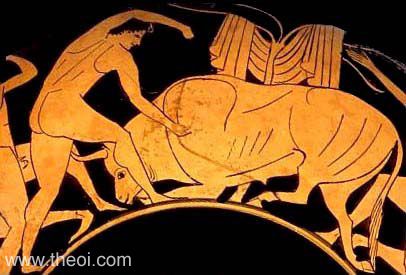
Pseudo-Hyginus, Fabulae 40 (trans. Grant) (Roman mythographer C2nd A.D.) :
"Pasiphae, daughter of Sol [Helios] and wife of Minos, for several years did not make offerings to the
goddess Venus [Aphrodite]. Because of this Venus [Aphrodite] inspired in her an unnatural love for a bull. At
the time when Daedalus came there as an exile, he asked her to help him. For her he made a wooden heifer, and
put in it the hide of a real heifer, and in this she lay with the bull. From this intercourse she bore the
Minotaur, with bull's head but human body. Then Daedalus made for the Minotaur a labyrinth with an
undiscoverable exit in which it was confined."
Ovid, Metamorphoses 8. 130 ff (trans. Melville) (Roman epic C1st B.C. to C1st A.D.)
:
"That adulteress [Pasiphae] who in a cow of wood beguiled a savage Bull and bore a monster [the Minotaur]
in her womb! . . . His [Minos'] dynasty's disgrace has grown; the monstrous beast hybrid beast declared the
queen's obscene adultery."
Ovid, Metamorphoses 9. 735 ff :
"Crete should lack no monstrous birth, [Pasiphae] the daughter of Sol (the Sun) [Helios] once loved a
Bull--a female with a male . . . her love had hope; her Bull, tricked by that bogus cow, served her--she had a
male to lead astray."
Ovid, Fasti 3. 499 ff (trans.Boyle) (Roman poetry C1st B.C. to C1st A.D.)
:
"The horns of a handsome bull captured my [Ariadne's] mother [Pasiphae]."
Ovid, Heroides 4. 165 ff (trans. Showerman) (Roman poetry C1st B.C. to C1st A.D.)
:
"[Phaedra addresses Hippolytos (Hippolytus) :] ‘My mother [Pasiphae] could pervert a bull; will you
be fiercer than a savage beast?’"
Virgil, Aeneid 6. 24 ff (trans. Day-Lewis) (Roman epic C1st B.C.) :
"Crete rising out of the waves; Pasiphae, cruelly fated to lust after a bull, and privily covered; the
hybrid fruit of that monstrous union--the Minotaurus (Minotaur), a memento of her unnatural love."
Propertius, Elegies 2. 32 (trans. Goold) (Roman elegy C1st B.C.) :
"Once was the wife of mighty Minos [Pasiphae], so they say, seduced by the snow-white form of a glowering
bull."
Propertius, Elegies 3. 19 :
"She [Pasiphae] who suffered the disdain of a Cretan Bull and put on the false horns of a timber cow."
Propertius, Elegies 4. 7 :
"The Cretan queen [Pasiphae] whose guile contrived the wooden monstrosity of a cow."
Seneca, Phaedra 112 ff (trans. Miller) (Roman tragedy C1st A.D.) :
"[Phaedra, daughter of Pasiphae, laments :] ‘I recognize my wretched mother's [Pasiphae's] fatal
curse . . . swept away by ill unspeakable, thou didst boldly love the wild leader of the savage herd [the Cretan
bull]. Fierce was he and impatient of the yoke, lawless in love, leader of an untamed herd; yet he did love
something. But as for me, what god, what Daedalus could ease my wretched passion? Though he himself should
return, mighty in Attic cunning, who shut our monster [the Minotaur] in the dark labyrinth, he could afford no
help to my calamity. Venus [Aphrodite], detesting the offspring of the hated Sol [Helios the Sun], is avenging
through us [i.e. Pasiphae and Phaedra] the chains that bound her to her loved Mars [Ares], and loads the whole
race of Phoebus [Helios] with shame unspeakable.’"
Nonnus, Dionysiaca 47. 395 ff (trans. Rouse) (Greek epic C5th A.D.) :
"[Ariadne speaks of her mother Pasiphae :] ‘My mother too once was the menial of a farmer [disguised
as a cow in the pasture], and bowed her neck for a herdsman, and prattled love to a dumb bull in the pasture,
and brought the bull a calf [the Minotaur]. She cared not to hear the herdsman make music on his pipe so much as
to hear the bellowing bull.’"
Suidas s.v. En panti muthoi kai to Daidalou musos (trans. Suda On Line) (Byzantine
Greek Lexicon C10th A.D.) :
"En panti muthoi kai to Daidalou musos--In every myth there is also the defilement of Daidalos
(Daedalus)-- : It is said that Pasiphae was in love with a bull and begged Daidalos to make a wooden cow and rig
it up and put her in it; and mounting her like a cow, the bull made her pregnant. From her the Minotauros
(Minotaur) was born . . . Since the origin and blame for these evils were attributed to Daidalos and he was
loathed for them, he became the subject of the proverb."
CRETAN BULL THE SEVENTH LABOUR OF HERACLES
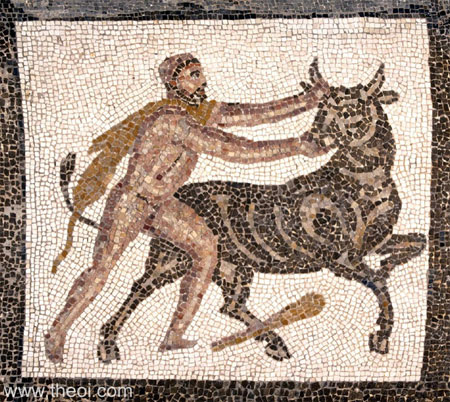
Pseudo-Apollodorus, Bibliotheca 2. 94 - 95 (trans. Aldrich) (Greek mythographer C2nd
A.D.) :
"The Kretan (Cretan) Bull. His [Herakles'] seventh labour was to bring back the Kretan bull. According to
Akousilaos (Acusilaus) [historian C6th B.C.] this was the bull that carried Europa for Zeus, but others say that
it was the bull that was sent by Poseidon out of the sea, the time Minos said he would sacrifice to Poseidon
whatever appeared from the sea. When he saw the beauty of the bull, he allegedly set it out to his herds and
sacrificed another one to Poseidon; this angered the god who turned the bull wild. Herakles arrived in Krete on
his mission, asked for help from Minos, was told to do his own fighting and capturing, did just that, and took
the bull back to Eurystheus. When he had shown it, he set it loose. The bull wandered to Sparta and over all of
Arkadia, then crossed the Isthmos and went as far as Marathon in Attika where it molested the natives."
Pausanias, Description of Greece 1. 27. 9 (trans. Jones) (Greek travelogue C2nd A.D.)
:
"The Kretans (Cretans) say that a bull was sent by Poseidon to their land because, although Minos was lord
of the Greek Sea, he did not worship Poseidon more than any other god.
They say that this bull crossed from Krete (Crete) to the Peloponnesos (Peloponnese), and came to be one of what
are called the Twelve Labours of Herakles. When he was let loose on the Argive plain he fled through the Isthmus
of Korinthos (Corinth)."
Diodorus Siculus, Library of History 4. 13. 4 (trans. Oldfather) (Greek historian
C1st B.C.) :
"The next Labour which Herakles undertook was to bring back from Krete (Crete) the bull of which, they say,
Pasiphae had been enamoured."
Quintus Smyrnaeus, Fall of Troy 6. 236 ff (trans. Way) (Greek epic C4th A.D.)
:
"[Depicted on the shield of Herakles' son Eurypylos (Eurypylus) :] Elsewhere portrayed was the
Fire-breathing Bull: the Hero's [Herakles] grip on his strong horns wrenched round the massive neck: the
straining muscles on his arm stood out: the huge beast seemed to bellow."
Pseudo-Hyginus, Fabulae 30 (trans. Grant) (Roman mythographer C2nd A.D.) :
"Twelve Labours of Hercules ordered by Eurystheus . . . The bull with which Pasiphae lay he [Herakles]
brought alive from the island of Crete to Mycenae."
Pseudo-Hyginus, Fabulae 38 :
"The bull . . . which Hercules had brought to Eurystheus from Crete."
Ovid, Metamorphoses 9. 186 ff (trans. Melville) (Roman epic C1st B.C. to C1st A.D.)
:
"My [Herakles] hands forced down the great bull's horns."
Seneca, Hercules Furens 230 ff (trans. Miller) (Roman tragedy C1st A.D.) :
"[The labours of Herakles :] The bull, the crushing terror of a hundred towns [i.e. of Krete
(Crete)]."
THESEUS & THE MARATHONIAN BULL
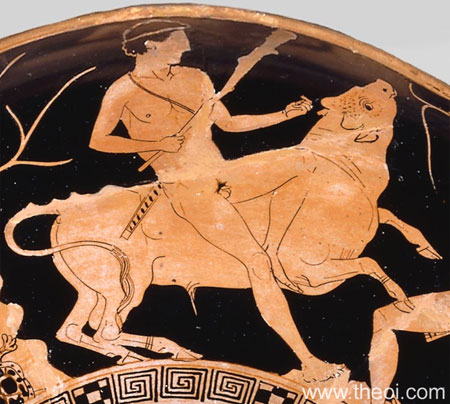
Pseudo-Apollodorus, Bibliotheca 2. 95 (trans. Aldrich) (Greek mythographer C2nd A.D.)
:
"When he [Herakles] had shown it [the Kretan (Cretan) Bull to Eurystheus], he set it loose. The bull
wandered to Sparta and over all of Arkadia (Arcadia), then crossed the Isthmos and went as far as Marathon in
Attika (Atticca) where it molested the natives."
Pseudo-Apollodorus, Bibliotheca 3. 15. 7 (trans. Frazer) :
"[King Aegeus] came to Athens and celebrated the games of the Panathenaia festival, in which Androgeos
(Androgeus), son of Minos, vanquished all comers. Him Aegeus sent against the bull of Marathon, by which he was
destroyed."
Pseudo-Apollodorus, Bibliotheca E1. 5 (trans. Aldrich) :
"Medeia, who was living at the time with Aegeus [King of Athens], plotted against Theseus, and got Aegeus
to be on guard against him as a designing person. So Aegeus, unaware that Theseus was his own son, sent him off
to fight the bull of Marathon. He destroyed it."
Strabo, Geography 9. 1. 22 (trans. Jones) (Greek geographer C1st B.C. to C1st A.D.)
:
"Marathon [in Attika] is the scene of the myth of the Marathonian Bull, which was slain by Theseus."
Pausanias, Description of Greece 1. 27. 9 (trans. Jones) (Greek travelogue C2nd A.D.)
:
"Another deed of Theseus they have represented in an offering, and the story about it is as follows :--The
land of the Kretans (Cretans) and especially that by the river Tethris was ravaged by a Bull. It would seem that
in the days of old the beasts were much more formidable to men, for example the Lion Nemeios (Nemean), the Lion
Parnassios (Parnassian), the Drakones (Dragon-Serpents) in many parts of Greece, and the Boars of Kalydon
(Calydon), Erymanthos and Krommyon (Crommyon) in the land of Korinthos (Corinth), so that it was said that some
were sent up by the earth (Ge), that others were sacred to the gods, while others had been let loose to
punish mankind. And so the Kretans say that this bull was sent by Poseidon to their land because, although Minos
was lord of the Greek Sea, he did not worship Poseidon more than any other god.
They say that this bull crossed from Krete (Crete) to the Peloponnesos (Peloponnese) , and came to be one of
what are called the Twelve Labours of Herakles. When he was let loose on the Argive plain he fled through the
Isthmus of Korinthos (Corinth), into the land of Attika (Attica) as far as the Attic parish of Marathon, killing
all he met, including Androgeos, son of Minos. Minos sailed against Athens with a fleet, not believing that the
Athenians were innocent of the death of Androgeos, and sorely harassed them until it was agreed that he should
take seven maidens and seven boys for the Minotauros (Minotaur) that was said to dwell in the Labyrinthos at
Knossos (Cnossus). But the Bull Marathonios (Marathonian) Theseus is said to have driven afterwards to the
Akropolis (Acropolis) and to have sacrificed to the goddess [Athene]; the offering commemorating this deed was
dedicated by the parish of Marathon."
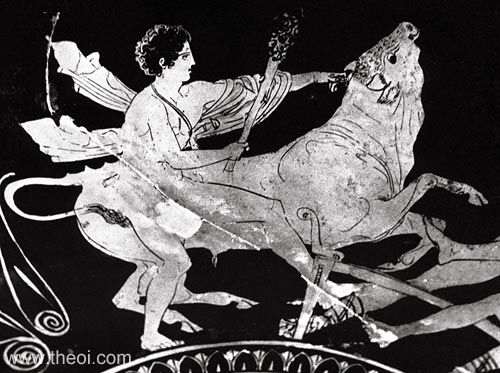
Diodorus Siculus, Library of History 4. 59. 6 (trans. Oldfather) (Greek historian
C1st B.C.) :
"Theseus came to Athens . . . then he grappled with the Marathonian Bull [father of the Minotauros] which
Herakles in the performance of one of his Labours had brought from Krete (Crete) to the Peloponnesos
(Peloponnese), and mastering the animal he brought it to Athens; this bull Aegeus received from him and
sacrificed to Apollon."
Plutarch, Life of Theseus 14. 1 (trans. Perrin) (Greek historian C1st to C2nd A.D.)
:
"Theseus, desiring to be at work, and at the same time courting the favour of the people, went out against
the Marathonian bull, which was doing no small mischief to the inhabitants of the Tetrapolis. After he had
mastered it, he made a display of driving it alive through the city, and then sacrificed it to the Delphinian
Apollon."
Pseudo-Hyginus, Fabulae 38 (trans. Grant) (Roman mythographer C2nd A.D.) :
"Labours of Theseus . . . He Killed the bull at Marathon, which Hercules had brought to Eurystheus from
Crete."
Ovid, Metamorphoses 7. 433 ff (trans. Melville) (Roman epic C1st B.C. to C1st A.D.)
:
"Great Theseus, mighty prince, you Marathon admires, since you destroyed the Cretan Bull (Taurus
Cretaeus)."
Statius, Thebaid 12. 672 ff (trans. Mozley) (Roman epic C1st A.D.) :
"[Theseus'] huge shield, and bears upon its boss . . . himself in the windings of the monstrous cave
twisting the shaggy neck of the struggling Bull, and binding him fast with sinewy arms and grip of either hand,
and avoiding the horns with head drawn back."
ANCIENT GREEK & ROMAN ART
SOURCES
GREEK
- Greek Lyric IV Bacchylides, Fragments - Greek Lyric C5th B.C.
- Apollodorus, The Library - Greek Mythography C2nd A.D.
- Apollonius Rhodius, The Argonautica - Greek Epic C3rd B.C.
- Diodorus Siculus, The Library of History - Greek History C1st B.C.
- Strabo, Geography - Greek Geography C1st B.C. - C1st A.D.
- Pausanias, Description of Greece - Greek Travelogue C2nd A.D.
- Plutarch, Lives - Greek Historian C1st - 2nd A.D.
- Philostratus the Elder, Imagines - Greek Rhetoric C3rd A.D.
- Quintus Smyrnaeus, Fall of Troy - Greek Epic C4th A.D.
- Nonnus, Dionysiaca - Greek Epic C5th A.D.
ROMAN
- Hyginus, Fabulae - Latin Mythography C2nd A.D.
- Hyginus, Astronomica - Latin Mythography C2nd A.D.
- Ovid, Metamorphoses - Latin Epic C1st B.C. - C1st A.D.
- Ovid, Fasti - Latin Poetry C1st B.C. - C1st A.D.
- Ovid, Heroides - Latin Poetry C1st B.C. - C1st A.D.
- Propertius, Elegies - Latin Elegy C1st B.C.
- Seneca, Hercules Furens - Latin Tragedy C1st A.D.
- Seneca, Phaedra - Latin Tragedy C1st A.D.
- Statius, Thebaid - Latin Epic C1st A.D.
- Statius, Achilleid - Latin Epic C1st A.D.
BYZANTINE
- Suidas, The Suda - Byzantine Greek Lexicon C10th A.D.
BIBLIOGRAPHY
A complete bibliography of the translations quoted on this page.
